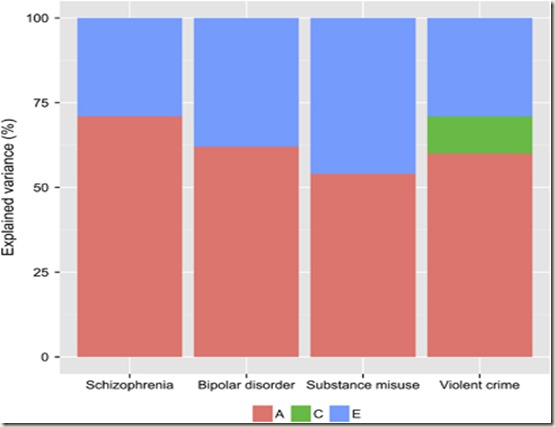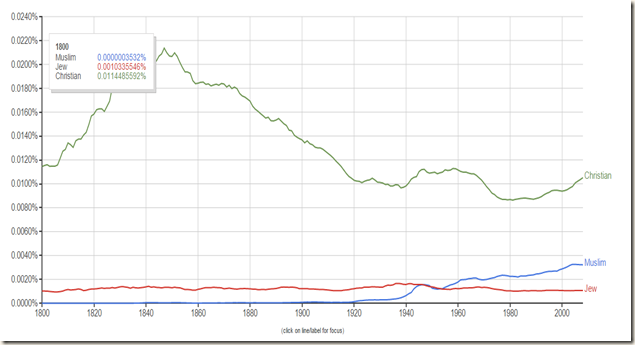
In June I reported on the work of Edward Dutton and Richard Lynn in “A negative Flynn Effect in France, 1999 to 2008–9” Intelligence 51 (2015) 67–70.
http://drjamesthompson.blogspot.co.uk/2015/06/is-france-sinking-even-further.html
I wrote that they had looked at a small but probably representative sample used by the Wechsler team in their 2011 French standardisation of the adult form of their general intelligence test. They say: The results of the French WAIS III (1999) and the French WAIS IV (2008–9) are compared based on a sample of 79 subjects aged between 30 years and 63 years who took both tests in 2008–2009. It is shown that between 1999 and 2008–9 the French Full Scale IQ declined by 3.8 points.
If true, this is a substantial drop in ability. The authors did not furnish an explanation, though they considered a few possibilities. In my comments I suggested a couple of reasons (apart from small sample size) that the results might not be as solid as imagined, but still felt that there had very probably been a drop in ability.
Now the paper has been looked at by Michael Woodley and Curtis Dunkel who examine causal explanations in more detail.
Michael A. Woodley of Menie and Curtis S. Dunkel. In France, are secular IQ losses biologically caused? A comment on Dutton and Lynn (2015) Intelligence, Volume 53, November–December 2015, Pages 81–85 doi:10.1016/j.intell.2015.08.009
https://drive.google.com/file/d/0B3c4TxciNeJZS1hPOHMyUGpOVVk/view?usp=sharing
The authors say: Dutton and Lynn report secular declines in Fullscale IQ evaluated using WAIS of four points a decade in France between the years 1999 and 2008–9. It is posited that the trend may have a partially biological cause, stemming from dysgenic fertility and, to a lesser extent, replacement migration. Given that these, and other biological phenomena are associated with the Jensen effect, it is expected that if they are the principal causes of the IQ decline then the secular change should also be associated with the Jensen effect. Furthermore if it can be demonstrated that the vectors of secular IQ decline, g loadings and the vectors of other biological indicators share variance, then the case for biological causation will be strengthened. Using the method of correlated vectors and error disattenuation, the secular IQ declines are shown to be associated with a high-magnitude Jensen effect (ρ = .833). A multi-vector common factor comprised of the vector of g loadings along with the vectors of three biological variables (subtest heritabilities, dysgenic fertilities and simple visual reaction times) was found to load substantially on the secular IQ decline vector (λ = .723). These findings indicate that the French secular IQ loss likely has a primarily biological cause.
How do the authors come to this conclusion?
It has been observed, with a few of exceptions, that variables which associate with IQ subtests to a greater extent, when the measure is more g loaded, tend to be biological (i.e. pertaining to genetic and physiological factors) and include factors such as population, race and species-level differences in cognitive ability ( Fernandes et al., 2014, Rushton, 1999 and Rushton and Jensen, 2010), subtest heritabilities ( Woodley of Menie, Fernandes, & Hopkins, 2015) and inbreeding depression effects ( Rushton, 1999 and Rushton and Jensen, 2010). Collectively these have been termed ‘Jensen effects’ ( Rushton, 1998).
Factors that exhibit the opposite tendency, i.e. associate with less g loaded abilities to a greater extent (and are in consequence ‘anti-Jensen effects’), are typically environmental or cultural in origin, such as IQ gains accrued via retesting ( te Nijenhuis, van Vianen, & van der Flier, 2007), gains accruing from the adoption of low IQ children into high IQ homes ( te Nijenhuis, Jongeneel-Grimen, & Armstrong, 2015), those accruing from intensive educational interventions ( te Nijenhuis, Jongeneel-Grimen, & Kirkegaard, 2014) and the Flynn effect ( te Nijenhuis & van der Flier, 2013).
First, they correlate the vector of French secular IQ decline magnitudes with the vector of subtest g loadings from the French standardization of the WAIS-III. This is the method of correlated vectors. They also correct for measurement errors.
Second, they construct a multi-vector common factor using the vector of the secular IQ declines and subtest g loadings along with the vectors of various biological indicators, including subtest heritabilities, Subtest-fertility (dysgenic) correlations and simple visual reaction time-subtest correlations.

The raw vector correlation is 0.38 and the corrected estimate 0.833. The corrections are reasonable, but the authors are clear that there is no way to get round the smallness of the sample, so I see this as just an indication of the underlying trend.

This adds in the dysgenics estimates and simple reaction time results, and the reliabilities, to give a much fuller and more intriguing picture.
Finally, they show the correlations of the vectors and bring the whole thing together:

Crucially, the loadings for g, heritability and secular IQ declines are all positive.
The authors say: The French secular IQ declines are associated with modest and large-magnitude (based on Cohen, 1988; small = .1 to .29, modest = .3 to .49, large = .5 to 1)1 Jensen effects when both the French WAIS-III normalization g loadings and the meta-analytic manual g loadings from Kan (2011) are used (r = .38 and .658 respectively; the two sets of g loadings exhibit a large-magnitude correlation: r = .626, N = 9 subtests). When corrected for four sources of error, the vector correlation between the French WAIS-III g loadings and secular IQ declines increases to .833 indicating a high-magnitude Jensen effect.
They concede that there is high measurement error, and they and the original authors agree on this point.
The results of the multi-vector analysis are consistent with Rushton's (1999) prediction that the vectors of biological variables and also g loadings should cluster with one another, forming a biological nexus. All loadings of the multi-vector common factor on its components are of large magnitude (λ = .505 to .854). The loading of the vector of secular IQ decline (λ = .723) indicates an association between this variable and other biological variables, which supports the speculation advanced in Dutton and Lynn (2015)concerning possible biological causes of the French IQ decline.
Replacement migration in France involving populations exhibiting lower means of IQ and higher rates of total fertility, such as Algerians, Moroccans, Tunisians and Roma (Čvorić, 2014 and Lynn and Vanhanen, 2012) may be increasing the rate of secular losses at the level of g, consistent with speculations advanced in Dutton and Lynn (2015), however the additional loss in g due to this process is anticipated to be very small. Based on a simulation, Nyborg (2012) estimates that in Denmark, replacement migration may be reducing heritable g by .28 points per decade, which would increase the overall loss in gto 1.51 points per decade ( Woodley of Menie, 2015), this still being only 37.75% of the loss observed in the French cohort.
Another possible contributing factor is the so-called “brain drain” (De Rugy, 2012), which involves high-g French individuals emigrating to countries that offer more competitive salaries and better working conditions. Thus human capital flight between 1999 and 2008–9, especially among the younger demographic, may have contributed to the French secular IQ decline, however the precise impact of the effect is difficult to determine.
Brain drain is certainly a possibility: the “South Kensington effect” of French emigres clustering round the Lycée français Charles de Gaulle is a result of London hosting roughly 270,000 French. The number is less significant than the fact of them being highly qualified and entrepreneurial, a real smart fraction.
Now the authors’ approach should be used to look at the more recent paper by Jakob Pietschnig and Georg Gittler on an equivalent fall in intelligence in Austria and Germany. Will they find the same result?
http://drjamesthompson.blogspot.co.uk/2015/11/deutschland-uber-alles-dann-unter-allen.html
It is a minor point, but authors reporting falls in intelligence sometimes describe it as “a negative Flynn Effect”. Whilst technically true, this somewhat underplays what is going on. If you strip out from the apparently rising scores that portion which is due to measurement error (changes in material, in scoring, in standardisation and possibly in student guessing) then the rest is assumed to be due to better environments: education, health and prosperity. The original assumption was that once everyone was on a level playing field of externally provided good circumstances, then intellects would reach a plateau of high functioning, but a plateau nonetheless. Jim Flynn said he was always surprised at how long the effect was continuing. He felt that once the deficits in living circumstances had been corrected, it would stop. However, as far as I know, no-one apart from those looking at dysgenics had predicted that intelligence would fall. I think we should refer to falling intelligence as Falling Intelligence. Either that, or follow Charles Murray in calling it the Woodley Effect
The work by Woodley and Dunkel serves as a general method of estimating the biological component in intellectual decline, a key explanatory component of the Woodley Effect. It should be tested widely.























